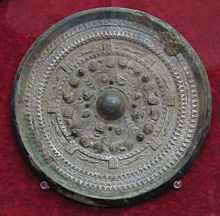Shinju-kyo
Japanese Shinjūkyō (神獣鏡, "deity and beast mirror") is an ancient type of round bronze mirror decorated with images of gods and animals from Chinese mythology. The obverse side has a polished mirror and the reverse has relief representations of legendary Chinese shen (神 "spirit; god"), Xian (仙 "transcendent; immortal"), and legendary creatures.

The shinjūkyō style of bronze mirror originated in China and was frequently produced during the Han Dynasty, Three Kingdoms, and Six Dynasties (1st-6th centuries CE). With the spread of Chinese bronze casting technology, shinjūkyō were also produced in Japan and the Lelang Commandery and Daifang Commandery in the Korean peninsula. The ca. 297 CE Wei zhi (魏志 "Records of Wei"), which is part of the Sanguo zhi (三國志 "Records of the Three Kingdoms"), has the first historical reference to bronze mirrors in Japan. It chronicles tributary relations between Queen Himiko of Wa (Japan) and the Wei court, and records that in 239 CE, Emperor Cao Rui sent presents to Himiko, including "one hundred bronze mirrors" (tr. Tsunoda 1951:15).
Archeological excavations of Japanese tombs from the Kofun period (3rd-7th centuries CE) have revealed numerous shinjūkyō, and Japanese archeologists divide them into subtypes including:
- sankakuen-shinjūkyō (三角縁神獣鏡, "triangular-rimmed deity and beast mirror")
- gamontai-shinjūkyō (画文帯神獣鏡, "wide image-band deity and beast mirror")
- hirabuchi-shinjūkyō (平縁神獣鏡, "flat-rimmed deity and beast mirror")
Kurotsuka kofun tomb excavated in Nara Prefecture contained 33 sankakuen-shinjūkyō bronze mirrors. Some scholars (Edwards 1998, 1999, Nishikawa 1999) believe they are the original mirrors that Emperor Cao Rui presented to Queen Himiko, but others disagree.
References
- Edwards, Walter. 1998. "Mirrors to Japanese History", Archeology 51.3.
- Edwards, Walter. 1999. "Mirrors on Ancient Yamato: The Kurozuka Kofun Discovery and the Question of Yamatai", Monumenta Nipponica 54.1:75-110.
- Nishikawa, Toshikatsu. 1999. "Sankakubuchi shinjukyo (Triangular-rimmed mirrors) and the Mirrors Presented to Himiko", Nihon Kōgaku 8:87-99.
- Tsunoda Ryusaku, tr. 1951. Japan in the Chinese Dynastic Histories: Later Han Through Ming Dynasties. Goodrich, Carrington C., ed. P. D. and Ione Perkins.
External links
- (Japanese) 7号鏡 神人龍虎画像鏡, Shinjūkyō picturing a transcendent, dragon, and tiger, Kobe Archeology Center (click image for navigation)
- (Japanese) 三角縁神獣鏡, Sankakuen- shinjūkyō from the Yoshinogari site, Kyoto University Museum